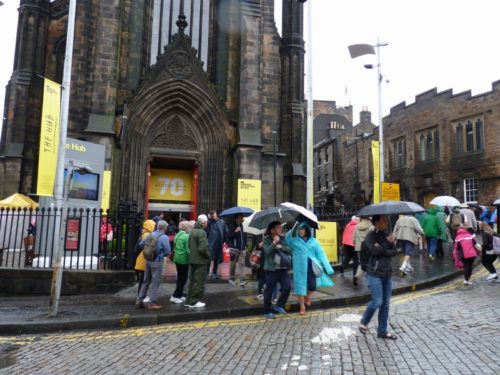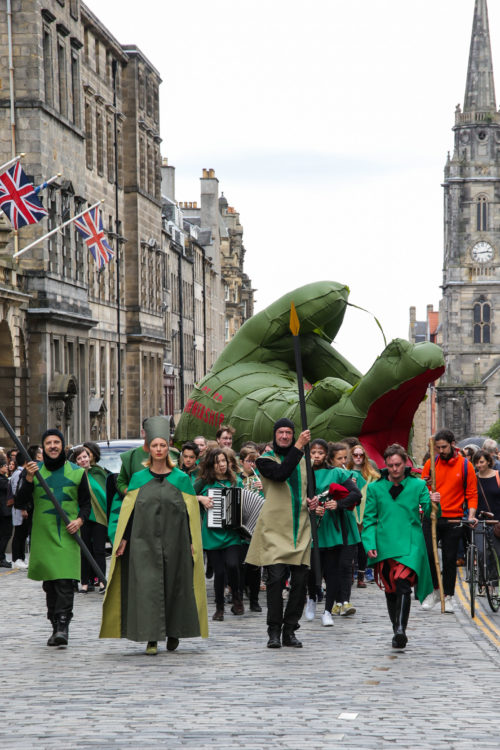Letter from Scotland

Edinburgh was an unlikely place for the largest arts festival in the world to begin, 70 years ago. Yet the project has proved an ever record-breaking success, despite the rain and umbrella-tossing wind which blows in from the North Sea for much of the three weeks of fun.
This year, appropriately, the central theme of the official festival is “Europe”. The Irish director Fergus Linehan has brought in operas and orchestras from Italy, Hungary and Norway and theatre and dance shows from 40 different countries. On the huge Fringe, which now dwarfs the official festival, performers are trooping in from over 60 countries.
And yes, there will be one or two mentions of Brexit. How ironic it is that Britain should be leaving the European Union, just as the festival is celebrating 70 years since it began as a vehicle to bring Europe together after the Second World War.
As I say, dour, cold, windy Edinburgh was an unlikely place to start a festival. But it was one of the few major cities in Britain not to be heavily bombed in the war and it is blessed with a suitable physique – dramatic hills, a proper castle and palace, and a compact city centre that can be walked around in 15 minutes.
But it wasn’t only these physical qualities that caused the greatest show on earth. It was the inspiration of two men – again unlikely heroes. One wasn’t even born here. Rudolf Bing was an Austrian Jew who fled Nazi Germany before the war and became an impresario in London. He started the Glyndebourne Festival and then turned his attention to Edinburgh, simply because he liked the place. His allay was John Falconer, a quiet Edinburgh lawyer who was Lord Provost at the time and managed to persuade every single member of the council that a festival was a good idea.
Rudolf brought the Vienna Philharmonic Orchestra and stars like Kathleen Ferrier and Alec Guinness to that first Edinburgh Festival. It proved a success. He organised another festival the following year and so it has growed, like Topsy.

Sir Rudolf Bing himself went on to run the Metropolitan Opera in New York for more than 20 years and ended his life rather sadly suffering from Altzheimer’s disease. At the age of 85, and after the death of his first wife, the Russian ballerina Nina Schelemskaja, he was hi-jacked into a second marriage by a mad 45 year old woman Carroll Douglass who took him off to live with her on an island in the Caribbean. A court later ruled that the marriage was null and void and friends took the poor old man back to New York where he died in 1997.
But his legacy lives on, in the music and the theatre and the dance. And, as usual, there is some edgy stuff this year. There’s a disturbing new play by Alan Ayckbourn “The Divide” which looks into a future where romance is banned because of fear of passing on a fatal disease. Eugene Ionesco’ play “Rhinoceros” is revived to remind us of the horrors of life under the Nazis. And then there is pop – with singers PJ Harvey, and Jarvis Cocker – and a couple of surrealist dance troops, one from the Netherlands and Anne Teresa De Keersmaeker’s Rosas company from Belgium.

The Festival Fringe began as just eight cheeky theatre companies nudging in, uninvited, to the first Edinburgh Festival. It’s now grown to 3,398 shows at 300 venues with a total of 53,000 performances.
There’s everything on the Fringe, from classical music, to children’s shows, musicals to gymnastics, Jane Austin to stand-up comedy. 35 per cent of the shows are now comedy. This year we have appearances from Ruby Wax, Sue Perkins, Clive Anderson. There are plenty of Brexit-inspired shows, like “Border Tales” and “Ballot Box” and a Brexit musical by Chris Bryant. Donald Trump is another star, with several shows devoted to bursting that particular balloon.

There is also an art festival and a book festival going on at the same time, and a military Tattoo on the castle esplanade. Edinburgh doubles in population during August, reaching close to the one million mark. Hotels, B&Bs, student halls, friend’s front rooms are all fully occupied. Restaurants and pubs are packed. The Royal Mile is crowded with people watching the street performers. This year the mile is interrupted by temporary bollards to guard against vehicle attacks by terrorists. It’s one of the fears haunting Europe after the attacks in Nice, Berlin and London.
The last time anyone calculated it (in 2015), the 12 festivals Edinburgh now stages through the year, Hogmany included, bring in £313m to the Scottish economy and create 6,000 jobs. It’s a huge business and a honey-pot of talent, and all in this apparently quiet Presbyterian city on the edge of Europe.